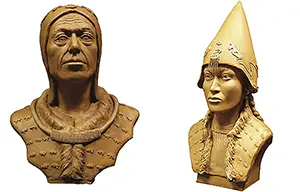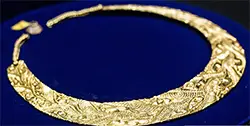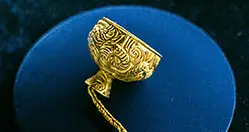|
Friday, August 15, 2025 Scythian 'Royalty' Comes Alive in 3D Facial Reconstructions
January 12, 2021 The visages of the famous Scythian "King" and "Queen" once again can be seen, thanks to months of painstaking recreation by anthropologists. 
Archaeologists from Germany and Russia found the pair of royals buried at the Arzhan-2 site in 1997 and made intensive study of them and their surroundings in the early 2000s. Using photogrammetry and laser scanning, the anthropologists from the Moscow Miklukho-Maklai Institute of Ethnology and Anthropology and from the Novosibirsk Institute of Archeology and Ethnography produced three-dimensional models of the pair's skulls. Their efforts were not without difficulty. Much of both skulls were missing. They had been disconnected from the rest of the skeletons and placed on a pillow near the rest of the bodies. But using modern understanding of how the skull is shaped, the teams completed both 3D models. The pair are thought to have been buried 2,600 years ago. They were part of the Scythian culture, which held sway in central Asia and the near Middle East to varying degrees for a few centuries. The nomadic Scythians began in what is now Iran, ruled the Medes for a time, and helped bring about the destruction of the Assyrian Empire in 612 B.C. The Sarmatians eventually ended the Scythians' dominance. The Scythians also contributed to much cultural exchange along the Silk Road, the vast trading network that connected West and East for a great many years. The wooden burial chamber was one of two concentric structures, made of larch logs, in a 262-foot-wide burial mound in Tuva, a remote republic in southern Siberia, near the border with Mongolia and the geographic center of Asia. Once ruled by China and Mongolia, Tuva became part of Russia in 1914.
Felt carpets covered the walls of the tomb, and the skeletons were carefully arranged on a purpose-built wooden floor. The archaeologists who found the pair termed them "king" and "queen" because they were the skeletons of a male and a female found together in the same grave and because the burial chamber contained a rich assortment of nearly 10,000 valuables, including many items made of gold. Near the male skeleton was a gold necklace, signifying the supreme importance of the wearer, and thousands of small gold figures of panthers. Near the queen were beads of turquoise, a golden bracelet, a number of gold badges and pins, a tiny gold cauldron, and an iron dagger that had gold decorations. Also found in the burial chamber was a flail, known as a symbol of authority. Some experts think that this was the first such item found in a burial chamber outside of Egypt. Archaeologists found the bones of another 33 people at the site. Also among the buried were 14 stallions, each horse from a different herd, again illustrating the wealth and power of the "king." |
|
Social Studies for Kids
copyright 2002–2024
David White






